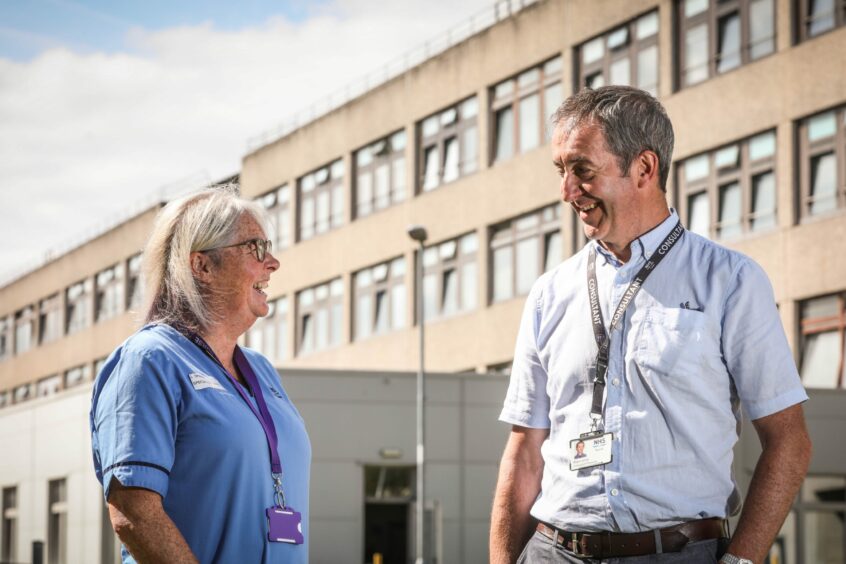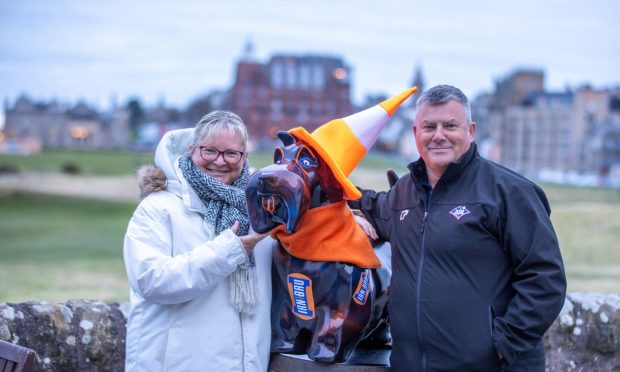Lynne Spence is one of a small team of specialist respiratory nurses supporting more than 4,000 people with sleep apnoea across Tayside.
Alongside more than 25 years of nursing experience, Lynne brings real insight to patients – as she has sleep apnoea herself.
“I went from the nurse who put patients on the treatment to the nurse who was also using it,” Lynne, from Perth, explains.
Here, she tells us how treatment for sleep apnoea changes lives, the family link that led to her own diagnosis – and the warning signs to look out for.
“In the respiratory liaison service we do other respiratory things, such as oxygen services, COPD, asthma etc, too.
“But around 30 patients a week are referred to the sleep apnoea service,” says Lynne.
“They’re sent by GPs or other departments such as weight loss or ENT clinics. They’ll have had diagnostic tests and come to us for treatment.
Snoring a sign of sleep apnoea
“They might be excessively tired during the day, be overweight or have high blood pressure. But the main symptom is snoring, or their partners reporting their snoring.”
There is no effective cure for sleep apnoea so patients wear a CPAP mask to manage their condition.
The machine pumps room air through a filter and into a face mask worn at night. This opens the airways so the patient gets a better night’s sleep.
“I say to patients it’s not like going to your GP for a prescription and taking a tablet,” Lynne says.
“This is a big tablet that you put on your face every night, seven days a week, 365 days a year because you are unlikely to not need it.”
‘I can relate to patients’
Lynne is open with patients about her own diagnosis.
“I tell my patients and it makes a huge difference. If you’ve never worn it you can’t understand what it’s like,” she says.
“If a patient has a problem I can relate to them.
“Symptoms for me were that I wanted to face-plank my desk in the afternoon because I was so tired.
“My sleep pattern was so bad, my son said the house vibrated with my snoring.
“I said ‘I don’t snore’, recorded myself and then was later diagnosed!
“I had an apnea-hypopnea index of 17 events per hour. So I either stopped breathing or had reduced breathing 17 times per hour.
‘They don’t realise life isn’t meant to be so tiring’
“Anything over 30 is seen as severe but I’ve had patients who had 145 events per hour.
“It’s a challenging science because some patients are very positive so don’t realise life isn’t supposed to be so tiring.
“Until they try the therapy and realise how it helps.”
“A CPAP machine is just plug and play,” says Lynne. “But getting used to the mask is the thing.
“The first time I wore it I didn’t like it. But I instantly knew it helped me.”
Sadly, it was only after Lynne’s dad died, and her sister was diagnosed with sleep apnoea, that she got her diagnosis too.
‘Sleep apnoea runs in families’
“Sleep apnoea runs in families,” she explains. “I lost my father and I suspect he had untreated sleep apnoea.
“He had a narrow jaw and overbite like I do, and he snored.
“He had heart failure and we wondered where that had come from.
“That was the driver to me getting checked out.”
And how do patients find having to wear a mask to sleep forevermore?
Lynne says: “People come to the clinic saying ‘this machine is the best thing that’s ever happened to me!
“Others say ‘I don’t like it but I know it works’. Partners say ‘The snoring stopped!’ Each patient is different.”
Lynne agrees the machine has made a big difference to her wellbeing.
“Absolutely. I sleep the whole night now, I don’t feel tired in the morning, I’m much more awake, I have much less brain fog than I used to.
“I will continue using it forever. Even if I go for an afternoon nap I use it.”
Signs you or your partner could have sleep apnoea
Lynne says these five signs could help identify cases of sleep apnoea:
- If you’re sleepy during the day rather than fatigued. We should all be able to watch a TV programme and choose not to fall asleep.
- Your partner is complaining about your snoring.
- You waken with a very dry mouth consistently.
- Feeling as if you haven’t slept or have a foggy head in the morning.
- You’re up to the toilet two or three times a night.
Post-menopausal women can develop sleep apnoea, Lynne says, because muscle tone relaxes in our bodies as we age.
And body builders with large necks or people with a collar size of 16.5 inches or more can be more susceptible to it.
“There are misconceptions about sleep apnoea,” Lynne adds. “So we need to get the message out there that people should not be frightened of seeking help.”
- For more information sleep apnoea groups locally can help. Scottish Association For Sleep Apnoea has a Dundee branch.


















Conversation